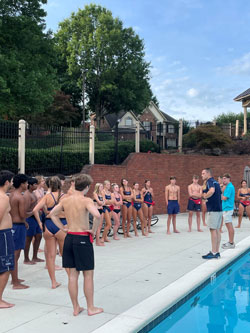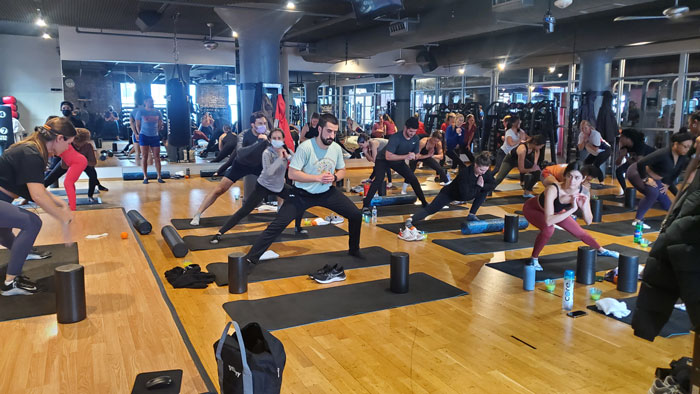When the pandemic finally seeped out of our everyday lives and allowed us to get back to our routines, it left some things in its wake, including staffing challenges, which are still being felt across many industries. The Great Resignation was real, and there were many reasons for the shakeup in the labor market, but the bottom line is that many employers are still struggling to fill positions, and scheming creative ways to address the problem.
The managed recreation industry was certainly not immune to these challenges. In fact, 60% of respondents to Recreation Management’s annual State of the Industry report listed staffing as their top challenge in 2023, down from 63% in 2022.
Kate Wollensack, executive vice president, chief People and Culture officer, YMCA of the USA, told us that YMCAs across the country—like many other organizations—had to reengage employees whose employment was paused, as well as attract new talent at the same time. “With health concerns lingering, Ys had one consistent advantage: our community-based culture,” she said. “Many employees who had worked for a Y wanted to return to their ‘work family.’”
So, do Ys recruit employees from their membership? “The Y absolutely looks to their members for new employees; members often make wonderful candidates,” exclaimed Wollensak.

And other strategies? “Many former employees were reinstated with service-based benefits, such as paid time off and defined benefit plan participation, when eligible. New hires were incentivized with hiring bonuses, some which included retention features.”
Wollensak said that pay raises and incentives were indeed a hiring option, especially in cases “where competition for talent jeopardized the Ys ability to deliver high-quality and safe programming.”
Wollensak mentioned aquatics and childcare as their largest staffing challenges, echoing many in the industry. And as one of the largest owner/operators of pools and camps, and one of the nation’s largest employers, it’s not surprising. “We’ve been concerned about potential lifeguard shortages for a number of years now, but COVID-19 and the current continued tight labor market have exacerbated the issue,” said Lindsay Mondick, director of Innovative Priorities and Aquatics Safety, YMCA of the USA.
Mondick discussed some staffing strategies, which included being “pipeline focused”; focusing on youth development and building lifeguard training into youth programming offerings. Also, being “transferable skills-focused. Being a lifeguard is more than just a job and earning money; it provides a person with skills that are transferable to any career path one may take. It builds confidence, leadership and improves one’s ability to work as part of a team,” said Mondick.
But Ys aren’t just engaging youth, they’re also focused on “non-traditional lifeguards,” and “engaging those who’ve retired, or those who formerly served their country in the military to now serve their community through lifeguarding positions.”
Some YMCAs also offer full-time positions, if they have indoor pools operating year-round, which also allows for training and certification year-round.
Additional strategies for attracting lifeguards have varied for Ys across the country, according to Mondick, ranging from “increased base pay, to incentives and referrals bonuses for referring friends, to providing free or paid training,” as well as those hiring and retention bonuses.

Sears Pool Management
Craig Sears, a member of the nonprofit Pool & Hot Tub Association (PHTA), operates a pool management company around the Atlanta area, managing around 60 facilities—including providing lifeguards—and doing maintenance for an additional 150-plus, mostly HOAs and condos, and some municipal facilities.
On the maintenance side, he said it’s indeed been harder to find service personnel. “We made some strategic changes to our operations over the pandemic, which worked out really well so far; we went with a less-is-more philosophy.”
As many businesses tweaked their operations, Sears said they also reconsidered their business model. “We pulled in our service area and shaved probably one quarter of our customers over the pandemic on purpose.”
He said they also improved their training program and increased pay, and now there’s far less turnover in maintenance staff.
And yes, Sears’ company experienced lifeguard shortages. Pre-pandemic, they would visit schools to help with recruiting, but of course schools were locked down. And once they could revisit, Sears said it’d become less fruitful, and they found recommendations to be better—family, friends, etc. “We’ve focused more on recruiting through the community and through our customers, contacting youth sports coaches, etc., and just asking our customers to put the word out there.”
Some customers put up recruiting signage, and they also utilized Facebook and other social media.
These tactics proved successful; in 2023, “We were fully staffed and then some at our facilities,” said Sears. And increasing lifeguard pay 35% to 40% certainly helped. “I think the industry had been stuck with low wages for too long, and that’s really hurt us.”
Additionally, they also offer overtime and holiday pay, and incentive pay when school is in session. And as other sectors had layoffs and there were fewer internships available, Sears said they had more college guards return, so they hired some middle management personnel to assist in the field, checking on and mentoring younger guards, etc.
Juliene Hefter is executive director and CEO of the Association of Aquatic Professionals, and she said they’ve also seen an uptick in hiring in many areas. “Those communities have implemented programs such as free lifeguard training, as well as actually paying individuals an hourly rate while they’re taking the training, similarly to what we’ve seen in other industries.” Other successful strategies Hefter mentioned include offering sign-on bonuses and bonuses for the total number of hours worked during the summer as long as the employee worked a minimum number of hours or through a specific end date.
Hefter agreed that hiring older staff can help fill gaps, and explained that when she operated aquatic facilities they’d engage their retired lap swimmers, community firefighters/paramedics and teachers. “They were great additions to our staff, and we’re seeing more of this. We’re seeing lots of retirement-aged individuals coming out of retirement to lifeguard again to… get some extra money and ensure that pools in their communities are able to stay open.”
In Bakersfield, Calif., the North of the River (NOR) Recreation and Park District provides recreation programs and facilities for the NOR community, serving approximately 153,000 residents and overseeing 24 park sites. District General Manager Bret Haney collaborated with Esther Grijalva, human resources director, and Jasmin LoBasso, superintendent for recreation and community services, to share some insights into their recent staffing experiences, which included challenges due to the pandemic, though it “seems to have stabilized over the last year.” And echoing others in the parks industry, they said that seasonal and part-time positions have historically been more difficult to fill.

Extensive outreach seemed to be the ticket for the NOR team, who listed some of their strategies: utilizing the agency website to advertise job openings; email blasts to employees requesting they share openings; posting job flyers at all district facilities; social media posts including Facebook and Instagram; advertising with local colleges; utilizing Calijobs, governmentjobs.com and recruiting resource NEOGOV; advertising on any position-related association job boards. They also connected with the local high school district’s CTECH campus, California State University and Bakersfield’s Student Recreation Center to share recruitments. “If a recruitment needs more support, we also share it on our regular interview segments with media.”
As far as training initiatives, the NOR team said they offer a paraprofessional written exam for the program leader position to replace the qualification for college units. “We’ll also hire individuals as substitutes for various positions, get them trained and work to familiarize them with their area, and as openings occur, we refer to the sub list before opening up a recruitment.”
They also promote from within, with parks and rec and aquatics personnel having opportunities for advancement based on work performance, training and number of years of service.
While there have been challenges with recruiting lifeguards, a couple of factors helped in this area, according to the NOR team, including operating one less pool. “We’ve limited the number of swim lesson sessions available in our season to account for staff training alongside school schedules. (And) we were able to collaborate closely with local media to shine a light on the impact of lifeguard shortages nationwide and in the area, and this coverage benefited us and other local aquatics programs.”
As far as incentives, “For new aquatics staff, individuals enrolled in NOR’s Lifeguard Training course and are hired to work that season will be reimbursed 50% of the course registration fee after working the summer season.”
The fitness industry was also not spared from staffing woes. Mark Miller is COO of Merritt Clubs, with eight locations in the Baltimore area. He said they’ve seen less interest and a tougher time recruiting personal trainers and instructors. “Now, on the group fitness side, it seems it may be more specialty-driven, meaning we get a lot of yoga instructors and yet group cycling instructors are very difficult.”
As for recruitment strategies, Miller said “We’ve been trying a lot of rifle shots and meet them where they are. So, demographic studies and direct mailers, using Instagram and TikTok and really using your current employees for like individuals.”
Miller strongly believes that offering continuing education and training opportunities are beneficial for attracting workers, and wholeheartedly believes in creating a strong company culture. “When you lead from the heart, you get the head and hands. If you can embrace it and do it, you save money, time and you become more profitable. Your employees stay longer and members also.”
Michaela Brown is general manager of VIDA Fitness & Aura Spa in Logan Circle, Washington, D.C., and like Miller, a member of IHRSA, the global health and fitness association. She said they’ve largely returned to normal as far as hourly workers and personal trainers, attributed to those professionals placing value on being part of a larger corporation with membership and health benefits, access to facilities and equipment, and a sense of community.

But Brown said they’re still seeing shortages with independent contractors—group fitness instructors and massage therapists—since during lockdown these entrepreneurs had to figure out how to maximize opportunities on their own. “This included streaming services online, doing house calls, etc. On the flip side, they were able to take home increased profits by removing the middle man.”
Brown explained that once clubs reopened, many independent contractors came back, but some continued to go solo. “To counter this reality, we… made a commitment to develop and grow talent from within. We’re doing this by offering in-house instructor trainings that specifically focus on maximizing and replicating the talent that we have now.”
VIDA offers many in-house trainings and partners with certification organizations so instructors and trainers receive continuing education credits. “We’ve found in-house trainings very successful because of the audience they attract,” said Brown, adding that members and both current and aspiring fitness instructors sign up in droves. And she pointed out that instructors who are already part of their community are more likely to “stay with us and reinvest their skills into (our) success.”
Additionally, they can increase engagement by utilizing these community relationships. “This decreases employee attrition and gives us the opportunity to build atop a strong foundation.”
When it comes to front-line workers like front-desk associates and housekeeping, Brown said “the pandemic gave us a whole new appreciation for these employees, for obvious reasons.” At her location, housekeepers were given a raise to up to $2 above grade. “It’s had a huge impact on our housekeeper retention and has gone the extra step of making those employees feel valued and appreciated for their work.”
Company culture is a big focus, and Brown described some regular activities including monthly kickoff meetings to learn about business updates, company-wide initiatives and departmental statistics. “These meetings always kick off with fun icebreakers to engage employees.”
There are culturally themed celebrations including Black History Month, AAPI Heritage Month, Hispanic Heritage Month, etc. “Every year we offer at least one company picnic and holiday party, open to all employees.

“Our diversity, equity and inclusion culture continues to be a huge draw for employees in the fitness, self-care and hospitality markets,” said Brown, who is on the VIDA Diversity & Inclusion board. “We’re three years into a Personal Training Scholarship and Mentorship program that has rendered us over 20 new personal trainers of color. We consistently integrate cultural awareness and inclusivity into our marketing, our membership initiatives and hiring practices.”
She said that when it comes to making all employees feel important, respected and part of a work family,
“prospective employees still want that, and it attracts them to us.”
“Employees today are looking for competitive pay, a strong culture and finding value in their jobs,” said Sears. “Helping them understand what your company culture is, how they fit in, how they contribute and the importance of their job is every bit as important as the pay.”
“Employees today want more,” agreed Miller. “They don’t want a job; they want fulfillment, a career, a purpose, to make an impact. We need to design our jobs today so they encompass that, take care of employees and make them want to be there.” RM



